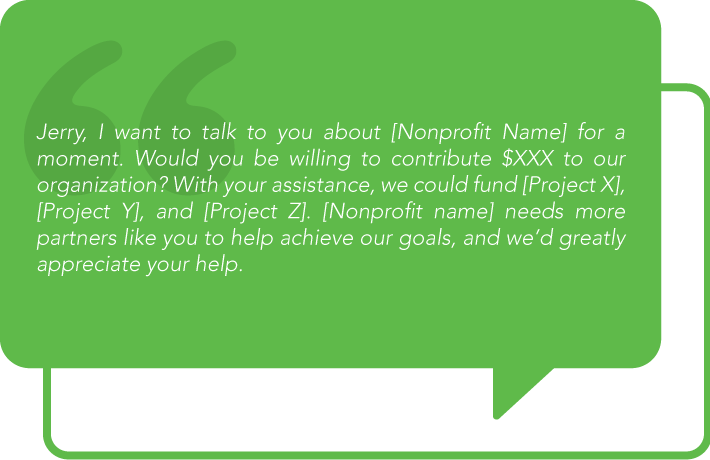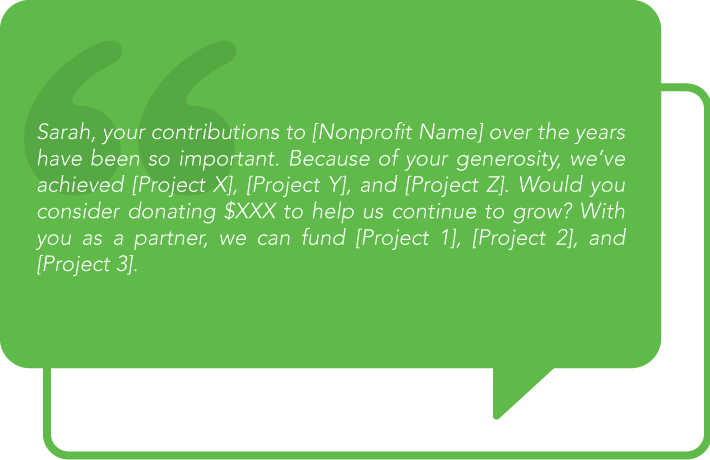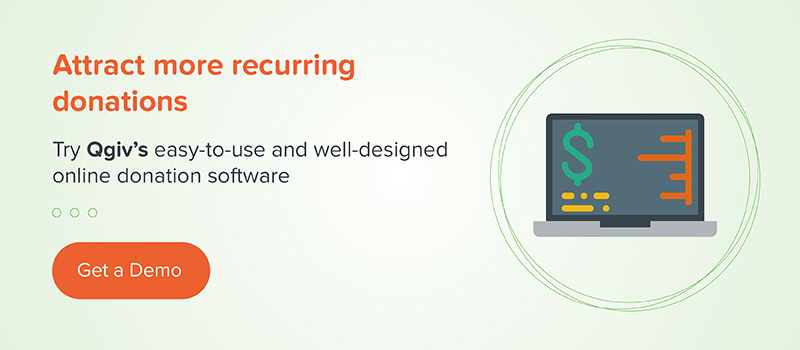
The internet — and even phones to some extent — have produced a certain amount of anonymity when it comes to asking for donations and making contributions. You can reach out to donors whom you have never met before, and they can feel moved enough to give their money to your organization.
However, sometimes you need to ask for donations in person at fundraising events or other functions. Not only does this help alleviate any miscommunication that can happen with less-human communication channels, but it also makes it easier for your organization to form more meaningful relationships with your donors.
The issue some people have with asking for donations in person is that it can be a nerve-wracking experience. Not only do you have to successfully pitch your organization’s mission and vision to someone who only has an outsider’s view, but you also must ask that person to contribute monetarily to your nonprofit. It can be a stressful and time-consuming endeavor.
Luckily, we have some advice! When asking for donations in person, keep these tips in mind:
- Do research beforehand
- Form a strong relationship before you make your ask
- Meet them where they are
- Practice your pitch
- Communicate in a variety of ways
- Be genuine, direct, and specific
- Be prepared for rejections
- Say thank you more than once
Take a look at the following eight best practices for asking for donations in person.
1. Do research beforehand
Most of the time, an in-person donation appeal indicates that the individual has the potential to be a major gift donor. While this isn’t always the case, think about the times in the past you’ve had to meet someone in person to ask for a donation.
Chances are those meetings weren’t for $25. They were probably for the amount your organization deems as a major gift.
People want to meet in person to get a good feel for your nonprofit and your cause before they write a sizable check. And just like they want to learn more about you, your nonprofit should do what it can to learn more about them.
Depending on your existing relationship with the individual, this research can take a variety of forms. If they are a friend or family member of someone who works with your organization, your research can begin with that person.
If they have given to your organization in the past, you can look at their past giving history to get a ballpark estimate of how much you should ask for.
If they have volunteered with your nonprofit previously, determine which events and projects they have given their time to. Knowing what they feel passionate about will help you better tailor your donation ask.
By completing some simple research before you start a donation appeal, you’ll be better off in the long run.
2. Form a strong relationship before you make the ask
Creating a strong relationship with a prospect goes hand in hand with doing research beforehand. You wouldn’t expect a birthday present from someone you just met, and you shouldn’t expect a donation from a brand new prospect.
Forming relationships with prospects takes time, but the results will be well worth the hours and the patience. Truthfully, you should be forming relationships with your donors and prospects anyway! Donors help your organization’s engine run, and having meaningful connections with them will ensure that they continue to support your cause in the future.
When forming relationships with prospects, let them talk about what interests them and what aspects of your organization they would like to support. Instead of over-inserting yourself every time you have a conversation, allow the dialogue to flow between what they can do for your organization and how your nonprofit can effectively utilize the resources they’d be willing to give you.
3. Meet them where they are
This point is double edged. When we say “meet prospects where they are,” we mean:
- Literally meet them where they are (or at least where they’re most comfortable). That could mean heading to someone’s office, the golf course, or meeting them virtually in their living room.
- Metaphorically meet them where they are. If a prospect expresses interest in giving a certain amount, don’t pressure them into giving more. Understand that they’re most knowledgeable about their finances and how to allocate them.
When you meet a prospect where they’re most comfortable, you take a lot of pressure off them. And, while this could mean that you’re more nervous, it helps to put your potential donor’s mind at ease.
It’s also important to remember to make the donation pitch about them. While you’ll definitely talk about your organization, remember that the goal is to get them excited and engaged. Highlight what they can do to help further your cause.
4. Practice your pitch
The last thing you want is to go into a meeting with a prospect and forget every point you were going to say. To help alleviate this fear, practice your pitch regularly!
While you don’t have to memorize a speech or carry note cards in your back pocket, you should review your pitch several times before making your official ask.
Practice in front of a mirror or with colleagues to make notes of your body language and any nervous gestures.
When practicing in front of others, ask them to help you prepare for any kind of answer you might receive from your prospect. While you can hope for a resounding “Yes!” from a prospect when you ask them for a donation, you have to be ready for a range of responses.
5. Communicate in a variety of ways
Even though you’ll be making the ask in person, it’s always a good idea to talk to prospects using different communication channels prior to and after making the ask.
These methods should include:
Talking to donors in a variety of ways should be a standard practice across the board. It’s especially important when communicating with potential major gift donors who you’ll be soliciting in person.
An in-person meeting can go a long way, but you wouldn’t want to take thirty minutes out of someone’s day when a quick email would suffice. This is especially true if you’ve been hosting typically in-person meetings virtually, because the collective Zoom fatigue is real. Balance is key.
6. Be genuine, direct, and specific
This is another point that should be standard practice whenever you ask for a donation, but it’s so important that it bears mentioning here.
Being genuine, direct, and specific not only shows that you are interested in a prospect or donor contributing to your cause, but it also demonstrates that you are invested in the cause as well.
People won’t want to give to an organization that you give half-hearted attention to.
Additionally, once you actually ask for a donation, don’t be vague. State a specific amount that you can back up with information gathered during your research stage. Directly ask for an amount, but remember to be flexible and let the prospect talk. Keeping the dialogue open will help ensure that you receive the donation you’re asking for.
Finally, let the prospect specifically know what the money would or could go toward. While this should have come up in previous conversations, it’s wise to let them know how you generally plan on allocating the money.
Check out these scripts for requesting donations from first-time donors and from recurring donors:
Donation Request Script for First-Time Donors

Donation Request Script for Recurring Donors

7. Be prepared for rejections
While you may think that supporting your nonprofit’s cause is the most important thing in the world, you must acknowledge that not everyone will think this way.
In fact, you have to be prepared for people to say no, maybe, or anything in between.
Of course, this doesn’t mean you should immediately give up. Instead, take a step back and evaluate your asking process. Adjust and tweak as you see fit and try again.
Having said that, don’t pester prospects until they’re annoyed. If they seem uninterested in giving money, offer other ways that they can give to your organization, either through volunteer time or by attending events.
8. Say thank you more than once
If you do receive a donation, make sure you’re following up with donors and thanking them.
This does not mean you say “Thanks!” after the ask is done and hope that covers it. You need to show donors that you sincerely appreciate their interest in and dedication to your organization:
- Send a personalized thank-you letter after the donation has been made.
- Stay in touch via email and social media.
- Highlight your donors in your annual report or somewhere on your website.
- Continue to meet donors in person when possible and thank them for their support.
By demonstrating your appreciation and highlighting your donors’ generosity, you are deepening your relationship with them which can lead to more donations down the line.
Final Thoughts
Asking for donations in person creates closer and more meaningful connections between nonprofit professionals, donors, and prospects. By following these eight best practices, you’ll be better poised to make your donation asks in person and raise more money for your organization’s cause.
Additional Resources
- Need to brush up on your donation requesting skills in general? Never fear! Check out our nine tips for asking for donations to get started.
- Looking for tips to help you plan your giving campaign? Check out this guide to planning your fundraising campaign.
- Still have questions? Be sure to consult our fundraising FAQ resource for more information on all things fundraising. Then sign up for our free Fundraising Boot Camp email series!








